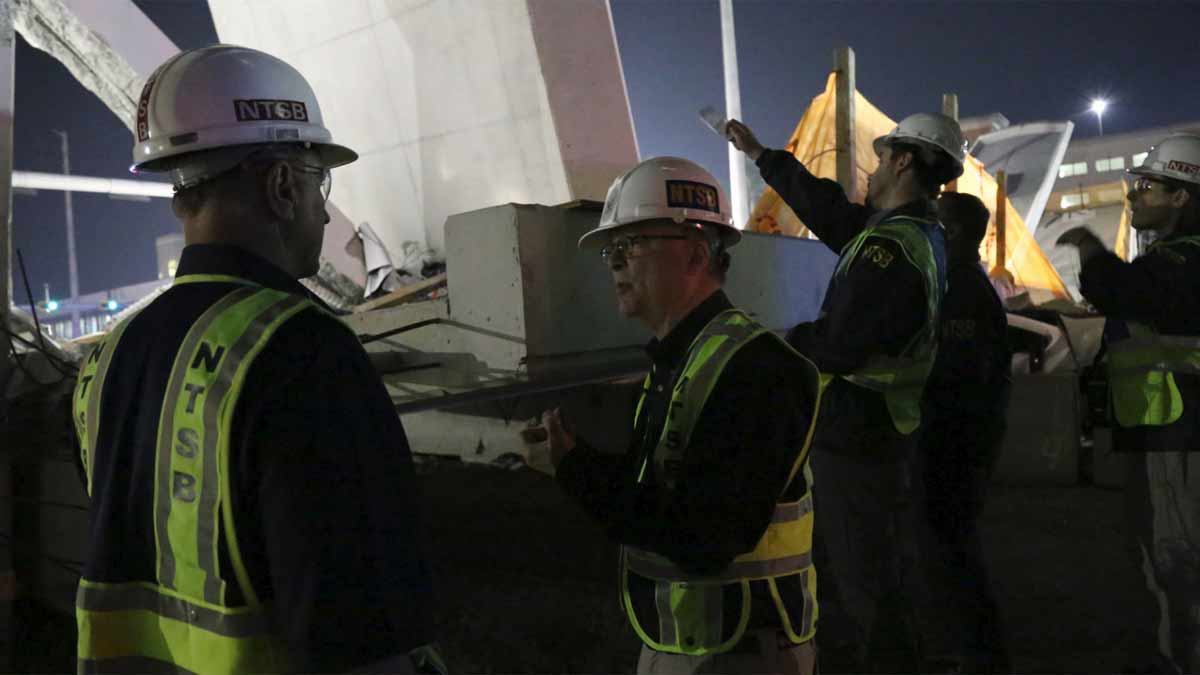On March 15, 2018, a pedestrian bridge over the Tamiami Trail, a seven-lane road in Miami, collapsed, crushing vehicles below. Officials have reported 6 people dead and 9 injured, but those numbers may grow. At this point, investigators are not even sure how many vehicles were crushed. Eight vehicles were visible from the exterior, and holes are being drilled to try determine if other vehicles are under the rubble.
Several federal agencies are investigating, including the National Transportation Safety Board (NTSB), Federal Bureau of Investigation (FBI), and the Occupational Safety and Health Administration (OSHA).
The NTSB Go Team for the investigation of the March 15, 2018, bridge collapse on Florida International University’s campus, arrived on scene at about 11 p.m. These and other photos available at the NTSB’s Flickr site https://t.co/2oQcssrCBd pic.twitter.com/9geMtnsJCj
— NTSB_Newsroom (@NTSB_Newsroom) March 16, 2018
As of this morning, officials are still searching the rubble looking for more victims and looking for evidence of what what went wrong. Because of the unstable condition of the bridge, rescue workers and engineers are putting themselves at risk.
The bridge was designed by FIGG Bridge Engineers and built by Munilla Construction Management. Barnhart Crane and Rigging operated the Self-Propelled Modular Transporters that placed the bridge on its permanent supports. Supposedly, the bridge was being built to withstand a category 5 hurricane. It had only been in place over the Tamiami Trail for 5 days before it fell.
2 of 3: NTSB investigators continue to request, and gather, documents about the design, construction and inspection of the FIU pedestrian bridge. pic.twitter.com/EMlmxmkKaW
— NTSB_Newsroom (@NTSB_Newsroom) March 17, 2018
The bridge was supposed to be a walkway connecting Florida International University (FIU) with Sweetwater, a Miami suburb.
“Every company and organization responsible for the collapse of the bridge needs to be held accountable.”Attorney Fred Pritzker
An FIU press release issued on March 10, just days before the bridge collapse, stated:
“The 174-foot, 950-ton section of the bridge was built adjacent to Southwest Eight Street using Accelerated Bridge Construction (ABC) methods, which are being advanced at FIU’s Accelerated Bridge Construction University Transportation Center (ABC-UTC). This method of construction reduces potential risks to workers, commuters and pedestrians and minimizes traffic interruptions. The main span of the FIU-Sweetwater UniversityCity Bridge was installed in a few hours with limited disruption to traffic over this weekend.”
The press release highlighted innovations in addition to ABC construction used to build the bridge:
“The FIU-Sweetwater UniversityCity Bridge is the largest pedestrian bridge moved via Self-Propelled Modular Transportation in U.S. history. It is also the first in the world to be constructed entirely of self-cleaning concrete. When exposed to sunlight, the titanium dioxide in the concrete captures pollutants and turns it bright white, reducing maintenance costs.”

Contact Pritzker Hageman Law Firm
By the end of construction, the cost of the bridge was estimated to be $14.2 million. Most of the funding for the project was a Transportation Investment Generating Economic Recovery (TIGER) grant from the U.S. Department of Transportation. Additional funding partners were the Federal Highway Administration, Florida Department of Transportation Local Agency Program, FIU and the City of Sweetwater.
In 2012, FIGG, the designer of the bridge, was fined $28,000 by the Virginia Department of Labor and Industry for violating safety rules after a portion of another bridge the company was building, this one in Virginia, fell 40 feet, injuring workers. On March 5, an airport worker filed a lawsuit alleging he was injured when a temporary bridge the company constructed at the Fort Lauderdale-Hollywood International Airport collapsed under the man’s weight.
